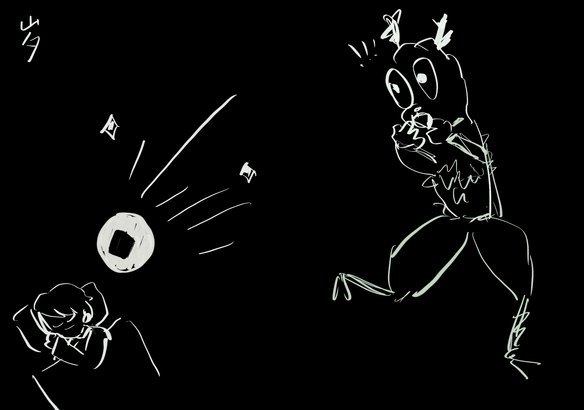
(Drawing by Liz Zhang, Sixth College,
UCSD, Class of 2026, by permission.)
Long ago there lived a frightful demon called Suì 岁 (“year”) with horns and claws and scales and huge green eyes. (Some people say red eyes.) And, being a frightful demon, of course it did evil things wherever it went.
Every year, on the eve of the Lunar New Year, when all the world was happy to be done with the old year with all its woes and to welcome in the possibilities for happiness that the new year might bring, Demon Suì would travel across the world looking for beautiful and innocent children fast asleep in their beds. It would peer at them for a moment to be sure they were sound asleep, and then stretch out a scaly hand and touch their little heads.
If he touched a child three times, something demonically terrible would happen. First, the baby would wake up and, seeing Demon Suì, would begin to howl in terror. By morning it would break into a fever. If it was old enough to talk, it would speak nonsense or gibber in unintelligible syllables. And as long as the child lived —which often was not very long— it was quite mad or quite stupid. Or both. Even brilliant children lost their minds and spent their remaining years as village idiots. And children whose destiny it had been to be village idiots anyway, achieved a certain sad fame by becoming even more foolish than the idiots of neighboring villages.
But for all his malice, Demon Suì was also very timid. Therefore he never dared to approach children who were awake, who could see him coming and scream for help. And so every New Year’s Eve, people tried to keep their children awake, a precaution they called “guarding against Suì” (shǒu Suì 守岁).
Although a tired child may flit and buzz like a restless fly, there comes a moment when he collapses into a deep sleep, and every parent knows how hard it is to wake a child who has only just fallen asleep. So keeping children awake to “guard against Suì” was often very difficult, and people invented all sorts of New Year toys to help with this. Indeed that is the origin of some of our most honored toys even today. Among these toys, it is said that one family wrapped bright coins in a little envelope made of red paper, and their toddler was up very late playing with the coins, which reflected the lamplight in wonderful ways.

Nevertheless, by midnight, the tot had collapsed; the coins lay helter-skelter on the floor beside him; the parents, who had resolved to sit up and keep watch, had themselves dozed off as well; and the lamp had burned itself out.
Naturally, in came Demon Suì, eager to touch the innocent little head. But as he headed across the room, a beam of moonlight reflected from a coin hit him directly in the eye, and he fled in fright. The parents, aroused from their own slumbers, arose just in time to see Demon Suì vanish, leaving their tiny child peacefully slumbering. They told everyone that the coins in their red paper envelope had sent away the dreaded demon.
Some people say that in actual fact, they were not normal coins. They were the famous Eight Immortals, who had used Daoist magic to transform themselves to appear as shiny coins, and Demon Suì had not fled from a moonbeam, but from the famous eight, who appeared before him as terrifying, demon-extinguishing warriors.
But ever since that time, on every New Year’s Eve, loving parents and grandparents have given children red envelopes containing money, which is therefore called yā Suì qián 压岁钱, which means “money for vanquishing Suì.”
(Today some people write the phrase with different characters (yā suì qián 押岁钱), so that it means “money to gamble away at New Year’s.” But that is because they don’t understand about demons.)